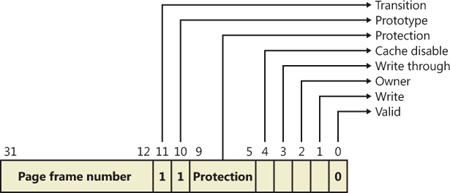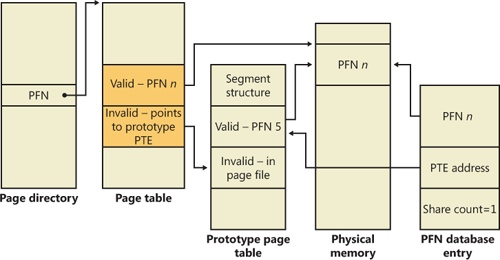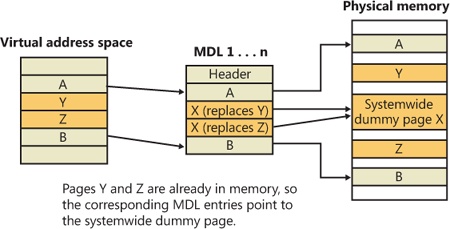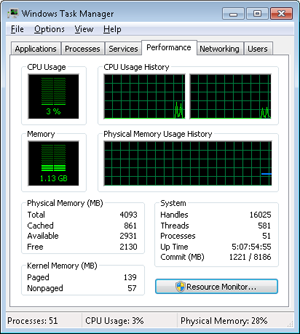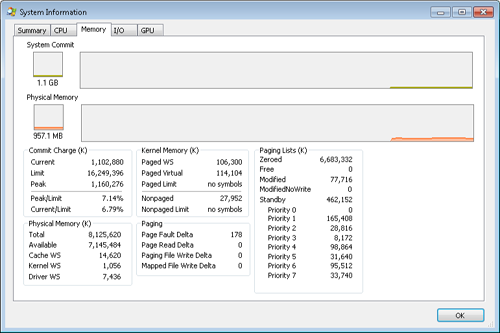Earlier, you saw how address translations are resolved when the PTE is valid. When the PTE valid bit is clear, this indicates that the desired page is for some reason not currently accessible to the process. This section describes the types of invalid PTEs and how references to them are resolved.
Note
Only the 32-bit x86 PTE formats are detailed in this section. PTEs for 64-bit systems contain similar information, but their detailed layout is not presented.
A reference to an invalid page is called a page fault. The kernel trap handler (introduced in the section “Trap Dispatching” in Chapter 3 in Part 1) dispatches this kind of fault to the memory manager fault handler (MmAccessFault) to resolve. This routine runs in the context of the thread that incurred the fault and is responsible for attempting to resolve the fault (if possible) or raise an appropriate exception. These faults can be caused by a variety of conditions, as listed in Table 10-13.
Table 10-13. Reasons for Access Faults
The following section describes the four basic kinds of invalid PTEs that are processed by the access fault handler. Following that is an explanation of a special case of invalid PTEs, prototype PTEs, which are used to implement shareable pages.
If the valid bit of a PTE encountered during address translation is zero, the PTE represents an invalid page—one that will raise a memory management exception, or page fault, upon reference. The MMU ignores the remaining bits of the PTE, so the operating system can use these bits to store information about the page that will assist in resolving the page fault.
The following list details the four kinds of invalid PTEs and their structure. These are often referred to as software PTEs because they are interpreted by the memory manager rather than the MMU. Some of the flags are the same as those for a hardware PTE as described in Table 10-11, and some of the bit fields have either the same or similar meanings to corresponding fields in the hardware PTE.
Page file The desired page resides within a paging file. As illustrated in Figure 10-26, 4 bits in the PTE indicate in which of 16 possible page files the page resides, and 20 bits (in x86 non-PAE; more in other modes) provide the page number within the file. The pager initiates an in-page operation to bring the page into memory and make it valid. The page file offset is always non-zero and never all 1s (that is, the very first and last pages in the page file are not used for paging) in order to allow for other formats, described next.
Demand zero This PTE format is the same as the page file PTE shown in the previous entry, but the page file offset is zero. The desired page must be satisfied with a page of zeros. The pager looks at the zero page list. If the list is empty, the pager takes a page from the free list and zeroes it. If the free list is also empty, it takes a page from one of the standby lists and zeroes it.
Virtual address descriptor This PTE format is the same as the page file PTE shown previously, but in this case the page file offset field is all 1s. This indicates a page whose definition and backing store, if any, can be found in the process’s virtual address descriptor (VAD) tree. This format is used for pages that are backed by sections in mapped files. The pager finds the VAD that defines the virtual address range encompassing the virtual page and initiates an in-page operation from the mapped file referenced by the VAD. (VADs are described in more detail in a later section.)
Transition The desired page is in memory on either the standby, modified, or modified-no-write list or not on any list. As shown in Figure 10-27, the PTE contains the page frame number of the page. The pager will remove the page from the list (if it is on one) and add it to the process working set.
Unknown The PTE is zero, or the page table doesn’t yet exist (the page directory entry that would provide the physical address of the page table contains zero). In both cases, the memory manager pager must examine the virtual address descriptors (VADs) to determine whether this virtual address has been committed. If so, page tables are built to represent the newly committed address space. (See the discussion of VADs later in the chapter.) If not (if the page is reserved or hasn’t been defined at all), the page fault is reported as an access violation exception.
If a page can be shared between two processes, the memory manager uses a software structure called prototype page table entries (prototype PTEs) to map these potentially shared pages. For page-file-backed sections, an array of prototype PTEs is created when a section object is first created; for mapped files, portions of the array are created on demand as each view is mapped. These prototype PTEs are part of the segment structure, described at the end of this chapter.
When a process first references a page mapped to a view of a section object (recall that the VADs are created only when the view is mapped), the memory manager uses the information in the prototype PTE to fill in the real PTE used for address translation in the process page table. When a shared page is made valid, both the process PTE and the prototype PTE point to the physical page containing the data. To track the number of process PTEs that reference a valid shared page, a counter in its PFN database entry is incremented. Thus, the memory manager can determine when a shared page is no longer referenced by any page table and thus can be made invalid and moved to a transition list or written out to disk.
When a shareable page is invalidated, the PTE in the process page table is filled in with a special PTE that points to the prototype PTE entry that describes the page, as shown in Figure 10-28.
Thus, when the page is later accessed, the memory manager can locate the prototype PTE using the information encoded in this PTE, which in turn describes the page being referenced. A shared page can be in one of six different states as described by the prototype PTE entry:
Active/valid The page is in physical memory as a result of another process that accessed it.
Transition The desired page is in memory on the standby or modified list (or not on any list).
Modified-no-write The desired page is in memory and on the modified-no-write list. (See Table 10-19.)
Demand zero The desired page should be satisfied with a page of zeros.
Page file The desired page resides within a page file.
Mapped file The desired page resides within a mapped file.
Although the format of these prototype PTE entries is the same as that of the real PTE entries described earlier, these prototype PTEs aren’t used for address translation—they are a layer between the page table and the page frame number database and never appear directly in page tables.
By having all the accessors of a potentially shared page point to a prototype PTE to resolve faults, the memory manager can manage shared pages without needing to update the page tables of each process sharing the page. For example, a shared code or data page might be paged out to disk at some point. When the memory manager retrieves the page from disk, it needs only to update the prototype PTE to point to the page’s new physical location—the PTEs in each of the processes sharing the page remain the same (with the valid bit clear and still pointing to the prototype PTE). Later, as processes reference the page, the real PTE will get updated.
Figure 10-29 illustrates two virtual pages in a mapped view. One is valid, and the other is invalid. As shown, the first page is valid and is pointed to by the process PTE and the prototype PTE. The second page is in the paging file—the prototype PTE contains its exact location. The process PTE (and any other processes with that page mapped) points to this prototype PTE.
In-paging I/O occurs when a read operation must be issued to a file (paging or mapped) to satisfy a page fault. Also, because page tables are pageable, the processing of a page fault can incur additional I/O if necessary when the system is loading the page table page that contains the PTE or the prototype PTE that describes the original page being referenced.
The in-page I/O operation is synchronous—that is, the thread waits on an event until the I/O completes—and isn’t interruptible by asynchronous procedure call (APC) delivery. The pager uses a special modifier in the I/O request function to indicate paging I/O. Upon completion of paging I/O, the I/O system triggers an event, which wakes up the pager and allows it to continue in-page processing.
While the paging I/O operation is in progress, the faulting thread doesn’t own any critical memory management synchronization objects. Other threads within the process are allowed to issue virtual memory functions and handle page faults while the paging I/O takes place. But a number of interesting conditions that the pager must recognize when the I/O completes are exposed:
Another thread in the same process or a different process could have faulted the same page (called a collided page fault and described in the next section).
The page could have been deleted (and remapped) from the virtual address space.
The protection on the page could have changed.
The fault could have been for a prototype PTE, and the page that maps the prototype PTE could be out of the working set.
The pager handles these conditions by saving enough state on the thread’s kernel stack before the paging I/O request such that when the request is complete, it can detect these conditions and, if necessary, dismiss the page fault without making the page valid. When and if the faulting instruction is reissued, the pager is again invoked and the PTE is reevaluated in its new state.
The case when another thread in the same process or a different process faults a page that is currently being in-paged is known as a collided page fault. The pager detects and handles collided page faults optimally because they are common occurrences in multithreaded systems. If another thread or process faults the same page, the pager detects the collided page fault, noticing that the page is in transition and that a read is in progress. (This information is in the PFN database entry.) In this case, the pager may issue a wait operation on the event specified in the PFN database entry, or it can choose to issue a parallel I/O to protect the file systems from deadlocks (the first I/O to complete “wins,” and the others are discarded). This event was initialized by the thread that first issued the I/O needed to resolve the fault.
When the I/O operation completes, all threads waiting on the event have their wait satisfied. The first thread to acquire the PFN database lock is responsible for performing the in-page completion operations. These operations consist of checking I/O status to ensure that the I/O operation completed successfully, clearing the read-in-progress bit in the PFN database, and updating the PTE.
When subsequent threads acquire the PFN database lock to complete the collided page fault, the pager recognizes that the initial updating has been performed because the read-in-progress bit is clear and checks the in-page error flag in the PFN database element to ensure that the in-page I/O completed successfully. If the in-page error flag is set, the PTE isn’t updated and an in-page error exception is raised in the faulting thread.
The memory manager prefetches large clusters of pages to satisfy page faults and populate the system cache. The prefetch operations read data directly into the system’s page cache instead of into a working set in virtual memory, so the prefetched data does not consume virtual address space, and the size of the fetch operation is not limited to the amount of virtual address space that is available. (Also, no expensive TLB-flushing Inter-Processor Interrupt is needed if the page will be repurposed.) The prefetched pages are put on the standby list and marked as in transition in the PTE. If a prefetched page is subsequently referenced, the memory manager adds it to the working set. However, if it is never referenced, no system resources are required to release it. If any pages in the prefetched cluster are already in memory, the memory manager does not read them again. Instead, it uses a dummy page to represent them so that an efficient single large I/O can still be issued, as Figure 10-30 shows.
In the figure, the file offsets and virtual addresses that correspond to pages A, Y, Z, and B are logically contiguous, although the physical pages themselves are not necessarily contiguous. Pages A and B are nonresident, so the memory manager must read them. Pages Y and Z are already resident in memory, so it is not necessary to read them. (In fact, they might already have been modified since they were last read in from their backing store, in which case it would be a serious error to overwrite their contents.) However, reading pages A and B in a single operation is more efficient than performing one read for page A and a second read for page B. Therefore, the memory manager issues a single read request that comprises all four pages (A, Y, Z, and B) from the backing store. Such a read request includes as many pages as make sense to read, based on the amount of available memory, the current system usage, and so on.
When the memory manager builds the memory descriptor list (MDL) that describes the request, it supplies valid pointers to pages A and B. However, the entries for pages Y and Z point to a single systemwide dummy page X. The memory manager can fill the dummy page X with the potentially stale data from the backing store because it does not make X visible. However, if a component accesses the Y and Z offsets in the MDL, it sees the dummy page X instead of Y and Z.
The memory manager can represent any number of discarded pages as a single dummy page, and that page can be embedded multiple times in the same MDL or even in multiple concurrent MDLs that are being used for different drivers. Consequently, the contents of the locations that represent the discarded pages can change at any time.
Page files are used to store modified pages that are still in use by some process but have had to be written to disk (because they were unmapped or memory pressure resulted in a trim). Page file space is reserved when the pages are initially committed, but the actual optimally clustered page file locations cannot be chosen until pages are written out to disk.
When the system boots, the Session Manager process (described in Chapter 13) reads the list of page files to open by examining the registry value HKLM\SYSTEM\CurrentControlSet\Control\Session Manager\Memory Management\PagingFiles. This multistring registry value contains the name, minimum size, and maximum size of each paging file. Windows supports up to 16 paging files. On x86 systems running the normal kernel, each page file can be a maximum of 4,095 MB. On x86 systems running the PAE kernel and x64 systems, each page file can be 16 terabytes (TB) while the maximum is 32 TB on IA64 systems. Once open, the page files can’t be deleted while the system is running because the System process (described in Chapter 2 in Part 1) maintains an open handle to each page file. The fact that the paging files are open explains why the built-in defragmentation tool cannot defragment the paging file while the system is up. To defragment your paging file, use the freeware Pagedefrag tool from Sysinternals. It uses the same approach as other third-party defragmentation tools—it runs its defragmentation process early in the boot process before the page files are opened by the Session Manager.
Because the page file contains parts of process and kernel virtual memory, for security reasons the system can be configured to clear the page file at system shutdown. To enable this, set the registry value HKLM\SYSTEM\CurrentControlSet\Control\Session Manager\Memory Management\ClearPageFileAtShutdown to 1. Otherwise, after shutdown, the page file will contain whatever data happened to have been paged out while the system was up. This data could then be accessed by someone who gained physical access to the machine.
If the minimum and maximum paging file sizes are both zero, this indicates a system-managed paging file, which causes the system to choose the page file size as follows:
Minimum size: set to the amount of RAM or 1 GB, whichever is larger.
Maximum size: set to 3 * RAM or 4 GB, whichever is larger.
As you can see, by default the initial page file size is proportional to the amount of RAM. This policy is based on the assumption that machines with more RAM are more likely to be running workloads that commit large amounts of virtual memory.
To add a new page file, Control Panel uses the (internal only) NtCreatePagingFile system service defined in Ntdll.dll. Page files are always created as noncompressed files, even if the directory they are in is compressed. To keep new page files from being deleted, a handle is duplicated into the System process so that even after the creating process closes the handle to the new page file, a handle is nevertheless always open to it.
We are now in a position to more thoroughly discuss the concepts of commit charge and the system commit limit.
Whenever virtual address space is created, for example by a VirtualAlloc (for committed memory) or MapViewOfFile call, the system must ensure that there is room to store it, either in RAM or in backing store, before successfully completing the create request. For mapped memory (other than sections mapped to the page file), the file associated with the mapping object referenced by the MapViewOfFile call provides the required backing store.
All other virtual allocations rely for storage on system-managed shared resources: RAM and the paging file(s). The purpose of the system commit limit and commit charge is to track all uses of these resources to ensure that they are never overcommitted—that is, that there is never more virtual address space defined than there is space to store its contents, either in RAM or in backing store (on disk).
Note
This section makes frequent references to paging files. It is possible, though not generally recommended, to run Windows without any paging files. Every reference to paging files here may be considered to be qualified by “if one or more paging files exist.”
Conceptually, the system commit limit represents the total virtual address space that can be created in addition to virtual allocations that are associated with their own backing store—that is, in addition to sections mapped to files. Its numeric value is simply the amount of RAM available to Windows plus the current sizes of any page files. If a page file is expanded, or new page files are created, the commit limit increases accordingly. If no page files exist, the system commit limit is simply the total amount of RAM available to Windows.
Commit charge is the systemwide total of all “committed” memory allocations that must be kept in either RAM or in a paging file. From the name, it should be apparent that one contributor to commit charge is process-private committed virtual address space. However, there are many other contributors, some of them not so obvious.
Windows also maintains a per-process counter called the process page file quota. Many of the allocations that contribute to commit charge contribute to the process page file quota as well. This represents each process’s private contribution to the system commit charge. Note, however, that this does not represent current page file usage. It represents the potential or maximum page file usage, should all of these allocations have to be stored there.
The following types of memory allocations contribute to the system commit charge and, in many cases, to the process page file quota. (Some of these will be described in detail in later sections of this chapter.)
Private committed memory is memory allocated with the VirtualAlloc call with the COMMIT option. This is the most common type of contributor to the commit charge. These allocations are also charged to the process page file quota.
Page-file-backed mapped memory is memory allocated with a MapViewOfFile call that references a section object, which in turn is not associated with a file. The system uses a portion of the page file as the backing store instead. These allocations are not charged to the process page file quota.
Copy-on-write regions of mapped memory, even if it is associated with ordinary mapped files. The mapped file provides backing store for its own unmodified content, but should a page in the copy-on-write region be modified, it can no longer use the original mapped file for backing store. It must be kept in RAM or in a paging file. These allocations are not charged to the process page file quota.
Nonpaged and paged pool and other allocations in system space that are not backed by explicitly associated files. Note that even the currently free regions of the system memory pools contribute to commit charge. The nonpageable regions are counted in the commit charge, even though they will never be written to the page file because they permanently reduce the amount of RAM available for private pageable data. These allocations are not charged to the process page file quota.
Kernel stacks.
Page tables, most of which are themselves pageable, and they are not backed by mapped files. Even if not pageable, they occupy RAM. Therefore, the space required for them contributes to commit charge.
Space for page tables that are not yet actually allocated. As we’ll see later, where large areas of virtual space have been defined but not yet referenced (for example, private committed virtual space), the system need not actually create page tables to describe it. But the space for these as-yet-nonexistent page tables is charged to commit charge to ensure that the page tables can be created when they are needed.
Allocations of physical memory made via the Address Windowing Extension (AWE) APIs.
For many of these items, the commit charge may represent the potential use of storage rather than the actual. For example, a page of private committed memory does not actually occupy either a physical page of RAM or the equivalent page file space until it’s been referenced at least once. Until then, it is a demand-zero page (described later). But commit charge accounts for such pages when the virtual space is first created. This ensures that when the page is later referenced, actual physical storage space will be available for it.
A region of a file mapped as copy-on-write has a similar requirement. Until the process writes to the region, all pages in it are backed by the mapped file. But the process may write to any of the pages in the region at any time, and when that happens, those pages are thereafter treated as private to the process. Their backing store is, thereafter, the page file. Charging the system commit for them when the region is first created ensures that there will be private storage for them later, if and when the write accesses occur.
A particularly interesting case occurs when reserving private memory and later committing it. When the reserved region is created with VirtualAlloc, system commit charge is not charged for the actual virtual region. It is, however, charged for any new page table pages that will be required to describe the region, even though these might not yet exist. If the region or a part of it is later committed, system commit is charged to account for the size of the region (as is the process page file quota).
To put it another way, when the system successfully completes (for example) a VirtualAlloc or MapViewOfFile call, it makes a “commitment” that the needed storage will be available when needed, even if it wasn’t needed at that moment. Thus, a later memory reference to the allocated region can never fail for lack of storage space. (It could fail for other reasons, such as page protection, the region being deallocated, and so on.) The commit charge mechanism allows the system to keep this commitment.
The commit charge appears in the Performance Monitor counters as Memory: Committed Bytes. It is also the first of the two numbers displayed on Task Manager’s Performance tab with the legend Commit (the second being the commit limit), and it is displayed by Process Explorer’s System Information Memory tab as Commit Charge—Current.
The process page file quota appears in the performance counters as Process: Page File Bytes. The same data appears in the Process: Private Bytes performance counter. (Neither term exactly describes the true meaning of the counter.)
If the commit charge ever reaches the commit limit, the memory manager will attempt to increase the commit limit by expanding one or more page files. If that is not possible, subsequent attempts to allocate virtual memory that uses commit charge will fail until some existing committed memory is freed. The performance counters listed in Table 10-14 allow you to examine private committed memory usage on a systemwide, per-process, or per-page-file, basis.
Table 10-14. Committed Memory and Page File Performance Counters
The counters in Table 10-14 can assist you in choosing a custom page file size. The default policy based on the amount of RAM works acceptably for most machines, but depending on the workload it can result in a page file that’s unnecessarily large, or not large enough.
To determine how much page file space your system really needs based on the mix of applications that have run since the system booted, examine the peak commit charge in the Memory tab of Process Explorer’s System Information display. This number represents the peak amount of page file space since the system booted that would have been needed if the system had to page out the majority of private committed virtual memory (which rarely happens).
If the page file on your system is too big, the system will not use it any more or less—in other words, increasing the size of the page file does not change system performance, it simply means the system can have more committed virtual memory. If the page file is too small for the mix of applications you are running, you might get the “system running low on virtual memory” error message. In this case, first check to see whether a process has a memory leak by examining the process private bytes count. If no process appears to have a leak, check the system paged pool size—if a device driver is leaking paged pool, this might also explain the error. (See the EXPERIMENT: Troubleshooting a Pool Leak experiment in the Kernel-Mode Heaps (System Memory Pools) section for how to troubleshoot a pool leak.)

